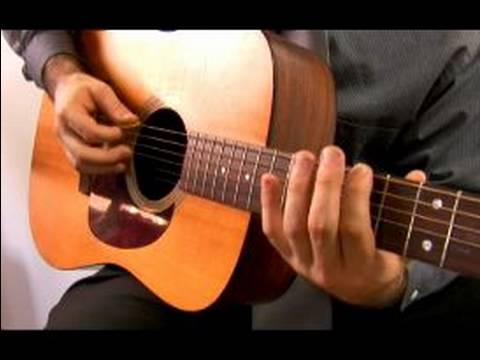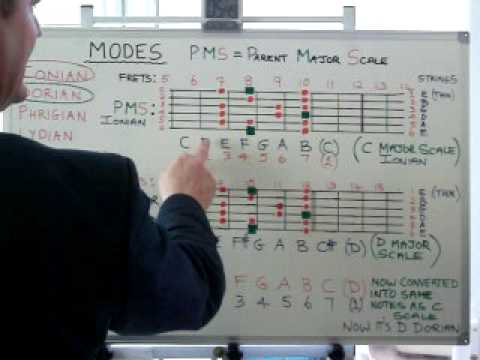Pitch Axis Theory, modes explained in a simple way using just one scale shape. Subscribe for new guitar lessons, gear demos and music each week. Forum & Store www.robchapman.tv Facebook http Chapman Guitars www.chapmanguitars.co.uk MonkeyFest http
You may also like
Introduction To Guitar Modes – Guitar Lesson
Added by Admin 11 years ago
885 Views1 Comments0 Likes
Get instant access to FREE guitar lessons at GuitarLessons.com . Learn how to play the 7 guitar modes in these guitar lessons! This section will run through all seven guitar modes and show a...
Modes & Guitar Solo Techniques: Music Lessons : Playing the Seven Guitar Modes in E Major
Added by Admin 11 years ago
635 Views0 Comments0 Likes
Learn how to play the seven 7 musical guitar modes in the key of E major in this free music lesson on video. Expert: Casey Cormier Bio: Casey Cormier has been playing both the guitar and bass for 10 years. Filmmak...
What Are Modes, How Are They Made, And Why? Easy Lesson Explaining A Complex Subject
Added by Admin 11 years ago
4.35K Views25 Comments0 Likes
What Are Modes, How Are They Made, And Why? Easy Lesson Explaining A Complex Subject. The subject of Modes can drive fear into the most seasoned of Guitarists & musicians but, it need not be...
German Schauss Guitar Quick Tip – “Using Modes on Guitar”
Added by Admin 11 years ago
1.03K Views1 Comments0 Likes
LAMA Guitar Instructor German Schauss discusses using different modes on guitar. www.lama.edu Video Rating: 4 / 5









Hello Ron, I was wondering if you could use the intervals in a mode to build new chords. For example, in the Phrygian Mode – key of C. The new 3 part harmony turns the 1 chord into Cminor, 4chord Fm …
What makes me feel better is the word, Mixolydian.
F# Dorian would be if you continued to play E major scales but start and finish it on the F#… over an F# chord or note drone. Dorian just means starting and stopping a major scale with the 2nd note of a major scale.
Just to clarify, those are the notes of C Minor.
You’re using the technique to find the “Parallel Minor,” not the “Relative Minor.” The notes you listed are C Minor, which is the “Parallel Minor” or C Major. The “Relative Minor”(in this case) is A Minor, and contains the same notes as C Major. Technically, the notes in the scale are C-D-Eb-F-G-Ab-Bb.
When you went back 2 steps and played that scale with the E droning behind it. You blew my mind sir.
518 south bailey street palmer alaska 99645 lol this is is where you can mail me a guitar so ican learn to play these lessons proper instead of this beat up classical you have a shitload so show some luv:)
you have a shitload so show some luv:)
How can I use this for different keys?
Im new to this, so can someone please answer my question.
What makes D major over E Dorian. I know that’s the right way, but wouldn’t F# (Which i know is wrong but that’s my point) be dorian since it’s the second note in the key of E.
is that red a pedal in the corner of the screen a wampler pinnacle?
1:10 I like your fingering
5:06 Anyone who can correctly ID the notes of the ringing cell-phone is a musical genius.
Wow thanks!!This scale makes me remember to Sonny Sharrock. That was a mate!
Thanks a lot, you didn’t only help, you answered my question perfectly and then some. The Monkey Lord himself couldn’t have answered it any better. I also wondered about the origin of the phrygian dominant scale and you solved that mystery for me as well. Thanks, I really appreciate it!
I’m not him, but I can answer. Generally, “major” / “minor” modes are defined by the quality of the third. Phrygian => minor third / mode, Lydian => major third / mode.
But your second comment is valid – it’s possible to harmonize other scales than the major scale, notably the harmonic and melodic minors. The fifth mode of the harmonic minor is “Phrygian Dominant” which can also be approached as “Phrygian with a Major (not minor) Third”. Hope that helps.
I have a question which I only entrust to the Monkey Lord. I have heard the Phrygian mode be referred to as a minor mode and I have heard the Lydian mode referred to as a major mode. When people refer to “major” and “minor” modes, are they referring to the major or minor character of the seven modes according to their intervalic values, or is there a such thing as a major Phrygian and a minor Phrygian? Thanks for the phenomenal videos milord!
When I learned the major scale I did it by learning the shapes as modes. e.g. for G major you learn the G major, A dorian, B phrygian, C lydian, etc. Eventually, when I learned the fretboard and where all the G notes were, I could play in any of the “mode” shapes but still play in G major by focusing on the right notes. Also, I think it’s the CHORDS that set the mood of a track more than the mode being used. If you play A aeolian over a C major backing track, it’s still gonna sound like C major.
it doesn’t really matter where the “shape” starts. if you look at the typical “aeolian mode” of c major for instance, the usual shape of it is an A minor pentatonic kind of shape right? with the root being A of course. But it’s also a C major scale if you “focus” on playing the C, E, G notes instead of typical “aeolian” sounding notes like A, and F. So it’s the context that matters. I would learn the shapes as you find them, but just keep in mind where the roots are.
you helped me understand alot sir .. htank u
If you want a basic introductions to modes on the KEYBOARD, try the modes tab at musicarta (that’s com, not co.uk))
maybe the best explanation ever!
im curious about something everything you say makes sense. but when i look at the major scale shapes online it doesnt start on the root for example the G major shapes appear to start on a open e .. i learned the scale as natural minor but i can see they are all the same just depending on the root placement. but using it as a major scale i dont know how i could move the root when they dont seem to start where i imagine it would as the first note.. i hope im making sense lol
I can’t thank you enough for this video. I was in a real rut in terms of trying to improve my lead playing, and this has helped me immensely LOVE YOU. And your beard.
LOVE YOU. And your beard.
I love the way you describe the scale sound against the tonic; measuring distances in your mind, called intervals. Interesting way of looking at it.